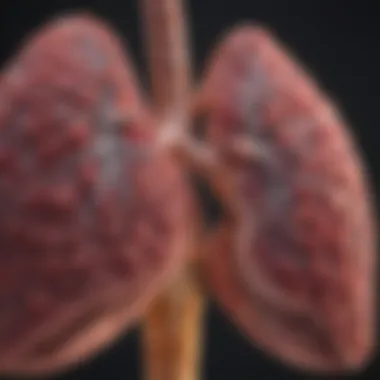Lung Cancer Statistics 2020: A Comprehensive Review


Intro
Lung cancer remains a leading cause of cancer-related deaths globally, highlighting the urgent need for thorough analysis and understanding of the disease. The statistics from 2020 reveal alarming trends that require attention from healthcare professionals, researchers, and policymakers alike. This narrative will break down the lung cancer statistics of 2020, looking closely at incidence rates, survival outcomes, and demographic differences that can guide future healthcare initiatives.
Understanding these statistics not only informs the medical community but also the general public about the risks associated with lung cancer. Through a comprehensive examination of data, we can identify patterns and disparities that indicate where focus should be directed to improve healthcare access and effectiveness. By synthesizing various data sources, the narrative aims to present a clear, concise representation of the state of lung cancer in 2020.
Methodologies
Accurate conclusions regarding lung cancer rates and outcomes rely heavily on robust research methodologies. Different research techniques play a crucial role in ensuring the validity of the statistics presented.
Description of Research Techniques
Researchers typically employ quantitative methods, utilizing large-scale data collections such as epidemiological studies and national health databases. Such studies encompass numerous variables, including age, gender, socioeconomic status, and geographic location. These variables help in painting a detailed picture of how lung cancer affects different populations.
Surveys and clinical trials also significantly contribute to understanding the disease. They help capture patient characteristics and treatment responses, revealing vital information about survival outcomes and quality of life. The collaboration between oncologists, epidemiologists, and public health experts is essential to compile and interpret this data effectively.
Tools and Technologies Used
The analysis of lung cancer statistics often involves sophisticated tools that enhance data processing and visualization. Software like SAS and SPSS play important roles in analyzing large datasets. These tools can perform regression analyses, survival modeling, and risk assessments, yielding insights that are crucial for understanding trends over time. Geographic Information Systems (GIS) also allow researchers to visualize cancer rates geographically, uncovering regional disparities in incidence and mortality.
Discussion
Comparison with Previous Research
When contrasting the 2020 statistics with earlier years, notable shifts emerge that require exploration. For example, the increase in lung cancer rates in younger populations was a key finding. Earlier studies may not have signaled such trends, suggesting a change in risk factors, possibly linked to smoking behavior or environmental exposures. This highlights the need for ongoing research to understand the evolving landscape of lung cancer.
Theoretical Implications
The insights gained from the comprehensive analysis extend beyond mere statistics. They hold theoretical implications for public health strategies as well. Understanding the demographics and risk factors behind lung cancer can lead to targeted prevention programs. For instance, communities with higher incidence rates may benefit from stronger smoking cessation initiatives and improved access to screening.
Comprehensive analysis of lung cancer data emphasizes critical areas for intervention and awareness, paving the way for more effective public health responses.
Ultimately, the data from 2020 informs future research directions and helps establish priorities for addressing the challenges posed by lung cancer. Both educational and policy-oriented approaches should evolve in response to the findings to enhance care and outcomes for affected populations.
Overview of Lung Cancer Statistics
Lung cancer remains a crucial subject within the healthcare conversation due to its substantial impact on global health. Analyzing lung cancer statistics provides valuable insights that facilitate understanding of the disease's incidence, mortality, and survival outcomes. This information is critical for devising effective public health strategies and enhancing patient outcomes. By examining this data closely, we can identify trends, highlight disparities, and understand the broader implications for healthcare systems around the world.
Global Incidence Rates
In 2020, lung cancer was diagnosed in approximately 2.2 million people globally, making it the most common type of cancer. The incidence rates have notable variations depending on geographic location, gender, and socioeconomic factors. For instance:
- Higher Rates: Countries in North America and Europe reported the highest rates of lung cancer incidence.
- Lower Rates: Regions in Africa and parts of Asia exhibited significantly lower incidence figures.
Some of the key factors influencing these incidence rates include smoking prevalence, pollution levels, and access to healthcare. As a result, studies show that smoking remains the leading cause of lung cancer, accounting for about 85% of cases. Understanding these figures is crucial for public health officials aiming to implement effective interventions tailored to specific communities.
Mortality Rates and Trends
Lung cancer mortality rates in 2020 reached approximately 1.8 million deaths worldwide, reiterating its role as the leading cause of cancer mortality. The five-year survival rate for lung cancer remains low, at around 19%, primarily due to late-stage diagnoses.
- Gender Disparities: Studies show that men tend to have higher mortality rates compared to women, linked to historical smoking patterns.
- Trends Over Time: Over the past decades, mortality rates have shown a decline in some high-income countries due to effective public health campaigns and smoking cessation programs.
However, in low and middle-income countries, mortality rates may continue to rise as healthcare systems struggle with detection and treatment capabilities. Improving early detection methods could profoundly influence these figures and promote better survival outcomes.
Prevalence and Survival Rates


The prevalence of lung cancer is a reflection of not just new cases but also the number of individuals living with the condition. In 2020, nearly 4 million individuals were identified as lung cancer survivors globally. Key points to note include:
- Survival Rates: Survival rates vary widely based on factors such as stage at diagnosis and treatment received. For localized lung cancer, the five-year survival rate is about 56%, but it drops dramatically for metastatic cases.
- Impact of Treatment: Advances in treatments, including targeted therapies and immunotherapy, have begun to slightly improve survival rates, indicating a need for greater focus on innovative therapies.
"Understanding lung cancer statistics helps us to shape future healthcare initiatives and ultimately saves lives."
In summary, the analysis of lung cancer statistics in 2020 reveals a complex landscape characterized by a need for targeted public health responses. Increased awareness and better access to diagnostic tools can lead to early detection, improved treatment, and higher survival rates, addressing the ongoing challenges of this pervasive disease.
Impact of Lung Cancer in Specific Populations
The analysis of lung cancer statistics is not just a matter of numbers; it reveals critical insights about how this disease affects various subgroups in society. Different populations experience lung cancer at differing rates and outcomes, influenced by factors like gender, age, ethnicity, and socio-economic status. Understanding these disparities is crucial for creating targeted public health initiatives and equitable healthcare policies. This section highlights how lung cancer behaves differently across distinct population segments, shedding light on the implications for prevention, treatment, and survival.
Gender Disparities
Lung cancer incidence and outcomes vary significantly between men and women. Traditionally, lung cancer has been associated predominantly with male patients due to historical smoking patterns. However, as smoking rates among women have increased, the incidence rates among females have seen a notable rise. In 2020, the statistics indicated that lung cancer is increasingly prevalent in women, particularly among younger cohorts.
Women tend to be diagnosed at different stages than men, often with more advanced disease. This disparity brings to the forefront the need for gender-sensitive approaches in both screening and treatment. Evolving awareness about female-specific symptoms and risk factors can lead to earlier detection, which improves prognosis.
Age Group Analysis
Age is a significant factor in lung cancer statistics. The likelihood of developing lung cancer increases with age, with the majority of cases occurring in individuals aged 65 and older. The 2020 statistics show a higher incidence during middle to late adulthood. Younger adults, while less commonly diagnosed, often face unique challenges, including late-stage discovery and potentially aggressive tumor behavior.
Understanding the age distribution of lung cancer cases helps guide screening recommendations. Programs targeting older populations can be crucial in reducing mortality rates. Conversely, awareness campaigns for younger adults might involve education about their risk factors, including tobacco use and environmental exposures.
Ethnic and Racial Variations
Ethnicity and race play vital roles in lung cancer statistics, influencing both incidence and outcomes. Research indicates that African American men have one of the highest rates of lung cancer in the United States. In contrast, Asian populations often exhibit lower incidence rates. Additionally, genetic factors and socio-economic conditions can contribute to the disparities seen among racial groups.
In 2020, lung cancer mortality rates also highlighted significant differences. Access to healthcare services, prevalence of smoking, and cultural stigmas surrounding the disease can affect screening practices and treatment options. Targeted interventions that consider these variations can improve health outcomes in at-risk communities.
Understanding the dynamics of lung cancer within specific populations is essential for addressing healthcare disparities.
By focusing on gender, age, and ethnic variations, we can better strategize public health efforts to combat lung cancer. A nuanced approach could not only enhance patient outcomes but also align resources effectively against this formidable public health challenge.
Geographic Distribution of Lung Cancer Cases
Understanding the geographic distribution of lung cancer is crucial for multiple reasons. Firstly, lung cancer does not affect all regions equally. It is influenced by environmental and lifestyle factors that vary per location. Knowing the statistics by region allows for targeted public health strategies and resource allocation. It helps authorities identify hotspots where incidence and mortality rates are significantly higher. Moreover, this data can guide policy decisions aimed at reducing risk factors, improving access to healthcare, and implementing efficient screening programs. The analysis of geographic distribution sheds light on the broader social determinants of health impacting lung cancer outcomes.
Regional Analysis
Lung cancer rates can differ markedly between regions due to several factors. In high-income countries, lung cancer incidence tends to be lower, primarily due to successful anti-tobacco campaigns and early detection measures. For instance, Europe and North America have made strides in reducing smoking rates and improving diagnosis with advanced medical technology.
Conversely, many lower-income countries experience higher lung cancer rates, exacerbated by inadequate healthcare infrastructure and limited access to preventative screening.
- High-Income Countries:
- Low-Income Countries:
- Lower incidence rates due to effective smoking cessation programs.
- Better access to diagnostic technologies and treatments.
- Higher prevalence of lung cancer due to environmental pollutants and lower awareness.
- Limited healthcare access hinders early diagnosis and treatment.
In regions such as Southeast Asia, lung cancer remains a significant public health concern, primarily due to smoking and high exposure to environmental carcinogens. This disparity underscores the need for global cooperation in research and healthcare initiatives focusing on areas with rising lung cancer cases.
Urban vs. Rural Disparities
The differences in lung cancer statistics between urban and rural areas are notable as well. Urban locations often have higher rates of lung cancer due to several environmental factors, including air pollution and occupational hazards. Industrial emissions and vehicle exhaust in cities contribute significantly to the risk of developing lung cancer.
In contrast, rural areas may see lower pollution levels, but they face their own challenges:


- Rural Areas:
- Limited access to healthcare services and cancer screening.
- Higher risk from exposure to agricultural chemicals.
Studies suggest that while urban residents might have access to better healthcare facilities, they may still face a higher risk due to lifestyle choices and pollution. On the other hand, rural populations may have less exposure to pollutants but might not receive timely medical attention or preventive care.
Such disparities in geographic distribution of lung cancer cases highlight the necessity for tailored public health approaches addressing the specific challenges of urban and rural populations.
"Understanding these geographic disparities is essential for combating lung cancer effectively and efficiently."
By recognizing and analyzing the distinct patterns of lung cancer across different regions and settings, stakeholders can better allocate resources, conduct relevant research, and ultimately improve lung cancer survival outcomes.
Risk Factors Associated with Lung Cancer
Understanding the risk factors associated with lung cancer is pivotal in grasping the complexities surrounding this disease. Lung cancer is a significant public health issue that leads to a high rate of morbidity and mortality worldwide. Identifying these risk factors can help individuals make informed decisions about their health, as well as aid healthcare providers in developing targeted prevention strategies.
Smoking and Tobacco Use
Smoking remains the principal risk factor for lung cancer. The majority of lung cancer cases are attributed to tobacco use. Cigarette smoking exposes the lungs to a multitude of carcinogens. These harmful substances damage lung cells over time, leading to mutations. The more a person smokes over the years, the greater their risk of developing lung cancer.
Quitting smoking can dramatically reduce the risk, even for long-term smokers. Recent studies show that individuals who stop smoking can lower their chances of lung cancer significantly, even years after quitting. Education about the dangers of smoking, especially among youth, is critical in combating this issue.
“Exposing youth to smoking has dire consequences, not only for their health but also for future generations.”
Environmental Exposures
Various environmental factors contribute to lung cancer risk, adding layers to its epidemiology. Exposure to radon gas, a naturally occurring radioactive gas found in homes, can lead to increased lung cancer risk. Workplace exposure to substances like asbestos, arsenic, and diesel exhaust fumes also significantly raises the likelihood of developing this disease.
Additionally, air pollution is an often overlooked yet substantial factor. Areas with high levels of particulate matter and other pollutants tend to report higher lung cancer incidences. Public awareness and policies aimed at improving air quality are fundamental for reducing this risk factor.
Genetic Predispositions
Genetics also play a role in lung cancer risk. Some individuals may inherit genetic mutations that increase their susceptibility to cancer when exposed to risk factors like tobacco or environmental toxins. Research indicates that people with a family history of lung cancer are at a higher risk of developing the disease themselves.
Understanding genetic predispositions can guide screening protocols and preventive measures, particularly for those with a strong family history. Genetic testing may help identify at-risk individuals, providing them with opportunities to engage in preventive strategies early on.
In summary, the interplay between smoking, environmental exposures, and genetic factors underscores the complexity of lung cancer. Addressing these risk factors requires a multifaceted approach, including public health initiatives focused on cessation programs, environmental regulations, and genetic research. By dissecting these risk factors, we can better strategize prevention and intervention efforts.
Advances in Lung Cancer Detection and Treatment
Advancements in lung cancer detection and treatment are pivotal in addressing one of the leading causes of cancer-related deaths worldwide. The continuous evolution of medical technology, alongside ongoing research, aims to improve outcomes for patients diagnosed with this malignancy. Early detection significantly increases the chance of successful treatment, making innovative screening methods and effective treatment options critical elements in reducing lung cancer mortality.
Screening Methods and Their Efficacy
Screening for lung cancer has gained attention as a means to capture the disease in its initial stages. Low-dose computed tomography (LDCT) has emerged as a standard screening method for high-risk populations, particularly those with a history of heavy smoking. The National Lung Screening Trial (NLST) has shown that LDCT can reduce lung cancer mortality by 20% compared to traditional chest X-rays.
Factors to consider when discussing screening methods include:
- Eligibility: Not everyone is suitable for screening. Specific criteria include age, smoking history, and overall health status.
- Frequency: Annual screening is recommended for certain high-risk individuals, allowing for timely detection.
- Accuracy: While LDCT is effective, false positives can lead to unnecessary anxiety and invasive procedures.
"Early detection through screening saves lives; it allows for interventions when the disease is more treatable."
Nonetheless, the benefits of screening must be weighed against potential harms. Understanding these complexities aids healthcare providers in making informed decisions regarding patient care.
Innovations in Treatment Approaches


Recent years have witnessed transformative changes in lung cancer treatment methodologies. Precision medicine plays a prominent role, where treatments are tailored according to an individual’s tumor genetic profile. Targeted therapies focus on specific mutations, leading to more effective treatments with often fewer side effects compared to traditional chemotherapy.
Types of treatment innovations include:
- Immunotherapy: This approach harnesses the body's immune system to fight cancer cells. Nivolumab and Pembrolizumab are notable examples in the context of non-small cell lung cancer (NSCLC).
- Targeted Therapy: Medications like Osimertinib are designed to target specific mutations such as EGFR mutations, offering effective treatment for certain lung cancer patients.
- Combination Therapies: A blend of different treatment modalities improves effectiveness. Combining immunotherapy and chemotherapy is a growing trend, aiming to enhance treatment outcomes.
Continued research and clinical trials are crucial in understanding how these innovations can further reduce lung cancer rates and improve survival outcomes. As professionals in the field strive to address the nuances in lung cancer management, these advanced treatment options pave the way for a future where lung cancer can be tackled more efficiently and effectively.
Challenges in Lung Cancer Management
Effective management of lung cancer presents numerous challenges that are deeply intertwined with various socio-economic factors. Addressing these challenges is crucial, not only for improving patient outcomes but also for alleviating the burden of this disease on healthcare systems worldwide. This section explores the barriers that hinder effective treatment and examines the access to healthcare services that patients frequently encounter.
Barriers to Effective Treatment
Barriers to effective treatment of lung cancer can emerge from multiple dimensions. Clinical, financial, and systemic obstacles all play a role in how patients receive care. Firstly, the complexity of lung cancer itself can hinder effective treatment plans. Lung cancer is highly heterogeneous, meaning its presentation and progression can vary significantly between individuals. This variability makes standardized treatment protocols difficult and often necessitates tailored approaches that may not be uniformly accessible.
Moreover, the financial burden associated with lung cancer treatment poses a serious obstacle. Many patients might struggle to afford the costs of advanced therapies, such as targeted treatments and immunotherapies, which are becoming common practice but often come with high price tags. This situation is further exacerbated in communities where health insurance coverage is insufficient or lacking.
Access to Healthcare Services
Access to healthcare services is another critical concern in the context of lung cancer management. Disparities in healthcare accessibility can result in delayed diagnoses and treatments, ultimately affecting patient prognosis. Within this framework, geographic location plays a significant role. Individuals living in rural areas may have limited access to specialized oncology care, diagnostic facilities, and the latest treatment options.
Urban areas typically provide a higher concentration of healthcare resources, but this does not eliminate disparities. For example, low-income neighborhoods may still face significant hurdles, such as limited transportation options and high out-of-pocket costs, which can prevent patients from reaching healthcare facilities.
Additionally, healthcare systems are often overburdened, making it challenging for patients to receive timely appointments or comprehensive care. Long wait times for specialists and diagnostic tests can lead to critical delays in treatment initiation. This situation highlights the need for systemic reforms to improve access, enhance patient navigational support, and ensure equitable distribution of resources.
Ultimately, tackling the challenges in lung cancer management not only requires direct interventions aimed at patients but also broader health policy changes that can improve accessibility, affordability, and quality of care for all individuals diagnosed with this formidable disease.
Effective lung cancer management necessitates addressing both clinical barriers and healthcare accessibility issues to ensure timely treatment and optimal patient outcomes.
Future Research Directions
The exploration of future research directions in lung cancer is vital in enhancing our understanding and management of this disease. As the landscape of lung cancer evolves, so do the approaches required to tackle its complexity. Research is crucial for several reasons. First, it allows for the identification of novel biomarkers that can help in early detection. This is significant because early-stage lung cancer often leads to better prognosis and survival.
Additionally, research can contribute to the development of targeted therapies that take individual patient profiles into consideration. Cancer is not a monolith; different patients may respond differently to the same treatment.
Ensuring effective strides in lung cancer management involves:
- Understanding genetic variations that influence disease progression
- Evaluating the effectiveness of new treatments across diverse populations
- Exploring the psychosocial impact of lung cancer on patients and their families
Moreover, targeted research initiatives can address the gaps in healthcare access that many patients face.
The implications of research thus extend beyond clinical trials. They influence public health policies that impact screening practices and healthcare resource allocation. Investment in lung cancer research can lead to more effective public health initiatives, ultimately reducing the global burden of this disease.
"The importance of ongoing research cannot be overstated as it is foundational to transforming lung cancer from a leading cause of mortality to a manageable chronic condition."
Emerging Trends in Lung Cancer Research
Research in lung cancer is continually advancing, with several emerging trends shaping the future landscape:
- Precision Medicine: Tailored treatment strategies based on individual genetic makeup are gaining traction. This approach aims to personalize therapies to enhance efficacy and minimize side effects.
- Immunotherapy: Techniques that harness the body’s immune response against cancer are being refined. Studies have shown promising outcomes, particularly with drugs like pembrolizumab and nivolumab.
- Liquid Biopsies: This innovative method allows for the detection of cancer-related genetic material in blood samples. Liquid biopsies facilitate non-invasive monitoring of treatment responses and disease progression.
- Understanding the Microbiome: Research is increasingly focusing on the role of the microbiome in lung cancer. The gut-lung axis may influence inflammation and immune responses, impacting treatment responses.
- Artificial Intelligence: AI is becoming integral in analyzing vast datasets for better prediction of treatment outcomes and patient management.
Finale
The significance of the topic discussed in this article cannot be overstated. The conclusion synthesizes critical insights drawn from lung cancer statistics in 2020, highlighting pivotal elements that inform both public health policy and individual awareness.
First, understanding lung cancer's incidence and mortality rates is vital. It allows healthcare professionals and policymakers to allocate resources efficiently. More specifically, these statistics can guide targeted interventions in at-risk populations, emphasizing the need for tailored screening programs.
Moreover, examining demographic variations in lung cancer trends enriches our comprehension of how different populations are affected. This awareness fosters a more inclusive approach to health strategies, ensuring that interventions address the unique challenges faced by diverse groups.
The analysis presented underscores the alarming disparities in healthcare access. Recognizing these issues is crucial for establishing equitable health systems. Adequate access to treatment and screening can potentially reduce mortality rates, making it a foundational aspect of future public health initiatives.
Another important aspect is the continuous evolution of research in lung cancer. By focusing on emerging trends, such as innovative detection methods and treatment strategies, we open new avenues for improving patient prognosis. This ongoing research is essential for adapting to the changing landscape of lung cancer care.



